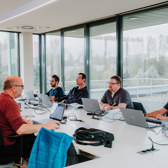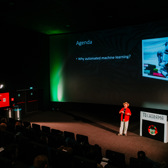Managing a Power BI Environment
UPBIM
3 days
Interested in a private company training? Request it here.
Not ready to book yet? Request an offer here.
Introduction to Enterprise Power BI
Overview of Power BI usage scenarios, collaboration methods, enterprise capabilities, and the importance of managing the Power BI Service, with a focus on licensing and pricing.
- Power BI Usage Scenarios
- Power BI Service Pricing
- The Power BI Architecture
- LAB: Diving into the Power BI Architecture
Configuring Workspaces
Workspaces are places where users collaborate to create semantic models, reports, dashboards and Dataflows. In this module students will learn how to secure, manage, and automate workspaces in an enterprise environment.
- Creating Workspaces
- Configuring Workspace - OneDrive Synchronization
- Workspace Connectivity with the XMLA Endpoint
- Managing Workspaces with PowerShell
- LAB: Configuring Workspaces
Configuring Workspace Security
This module discusses the different workspace security roles and the consequences of these roles when sharing dashboards and reports with other users.
- Configuring Workspace Security
- Security when Sharing Dashboards and Reports
- Row-Level and Object-Level Security
- Workspace Apps vs Org Apps
- LAB: Securing Workspaces
Creating and Managing Semantic Models
Learn how to build, connect, and manage semantic models in the Power BI Service. This module covers enterprise-wide BI practices, reusing and endorsing models, and integrating with Git for version control.
- Working with Semantic Models in the Power BI Service
- Toward Enterprise-wide BI
- Connecting to Existing Semantic Models
- Endorse and Discover Semantic Models
- Git Integration in the Power BI Service
- LAB: Connecting to and Configuring Semantic Models
Refreshing Semantic Models
Learn how to keep reports up to date with scheduled refreshes, optimize efficiency with incremental refresh, and enable on-premises refreshes with data gateways.
- Refreshing Online vs On-Premises Data Sources
- Configuring Data Refresh Credentials
- Configuring and Monitoring Data Gateways
- Scheduling Refreshes
- Configuring Incremental Refresh
- Improving Refresh Performance with Query Folding
- LAB: Configuring Data Refreshes
Semantic Models and External Tools
Learn how to work with PBIP project files, adjust semantic models with Tabular Editor, manage versioning with ALM Toolkit, and automate deployments using PowerShell.
- Power BI Projects and Source Control
- Adjusting and Deploying Semantic Models with Tabular Editor
- Versioning and Deploying using ALM Toolkit
- Semantic Model Deployment using PowerShell
- Other External Tools: Business Ops, Bravo, Measure Killer, ...
- LAB: Deploying and Versioning Semantic Models
Working with Dataflows
Dataflows bring Power Query to the cloud, enabling the reuse of data preparation logic across semantic models. Learn how to create, manage, and integrate Dataflows within Power BI and other Microsoft technologies.
- Dataflows Gen1 vs Gen2
- Dataflows and External Storage
- Working with Linked and Computed Tables
- Scheduling Refreshes for Dataflows
- Using Dataflows in Power BI
- Dataflow Licensing
- LAB: Working with Dataflows
Deploying Content using Deployment Pipelines
Deployment pipelines ensure safe movement of Power BI content across development, test, and production. Learn how to configure and use pipelines to apply proper Application Lifecycle Management.
- The Need for Different Workspaces
- Configuring Deployment Pipelines
- Using Deployment Pipelines for reporting ALM
- CI/CD for Semantic Models, Dataflows and Apps
- Getting the Most out of Deployment Pipelines
- LAB: Working with Deployment Pipelines
Monitoring Power BI
Monitoring the Power BI Service is crucial to spot performance issues and to estimate capacity. Auditing is also important from a security point of view.
- Using the Admin Monitoring Workspace
- Monitoring Workspace Usage
- Customizing Workspace Usage Reports
- Using Workspace Monitoring Eventhouses
- Power BI Premium Capacity Metrics and Alerts
- Power BI Activity Log for Advanced Logging
- Unified Microsoft 365 Audit Logging
- LAB: Monitoring the Power BI Service
Administering a Power BI Tenant
Tenant settings control visuals, sharing, and security across the organization. Learn how to configure these settings to enforce policies and best practices in Power BI.
- Tenant Settings Overview
- Configuring Tenant Settings
- Configuring Organizational Themes
- Tenant Settings Best Practices
- Sharing Settings
- Custom Visuals Settings
Capabilities Overview: Pro, Premium and Fabric
Learn how Power BI capabilities differ across Pro, Premium, and Fabric licenses. This chapter highlights usage scenarios, deployment strategies, and best practices to maximize value based on your organization’s licensing model.
- Usage Scenarios
- Semantic Model Management
- ALM Strategies
- Dataflows
- Monitoring & Governance
- Cost vs Performance Trade-offs
Power BI is a suite of business analytics tools designed to analyze data and share insights. This training focuses on setting up and managing Power BI in an enterprise environment, addressing challenges such as versioning, data lineage, deploying large semantic models, and security.
BI and IT professionals responsible for deploying and managing Power BI solutions in the cloud at an enterprise level. Some prior experience with Power BI Desktop is expected but not required.









